
Original Link: https://www.anandtech.com/show/2295
µATX Overview: Prelude to a Roundup
by Gary Key on August 7, 2007 4:00 AM EST- Posted in
- Motherboards
Introduction
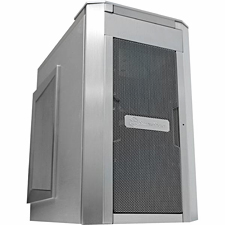 |
That's right, we over-emphasized the new article features to the detriment of our primary focus, providing a motherboard roundup that featured the often ignored but market leading µATX form factor. What started out with adding a couple of features such as IGP video quality comparisons and midrange CPU performance turned into a maze of thoughts and ideas that led us to believe it would be quite easy to add additional tests without affecting the overall schedule too much. We were wrong, but we hope that our future motherboard articles will be better for it.
How did we get stuck in the quagmire of µATX hell? It began with innocent thoughts of adding budget to midrange CPU coverage, low to midrange graphics comparisons against the IGP solutions, High Definition playback comparisons utilizing not one but each competing standard, Windows XP versus Vista versus Linux, onboard audio versus add-in cards, and even tests of input devices and external storage items. It ended with our project scope changing from being motherboard specific to platform encompassing.
We started down that path but despite periodic excitement, at times we also ended up with a dreaded case of paralysis by analysis syndrome. Don't get us wrong: we do not regret the effort that has been expended on this roundup; however, we sincerely regret the time it has taken to complete it and we apologize to those of you who have been waiting months for this information. It turns out that we ignored one of our favorite quotes from C. Gordon Bell, "The cheapest, fastest, and most reliable components are those that aren't there." That is one of the many factors that caused us problems, as it became quite obvious during testing that getting all of this equipment to work together and then benchmarking as planned was not exactly going to be a walk in the park.
We have been constantly waiting on that one BIOS or driver to fix a malady of problems that we've discovered along the way. The manufacturers would ask - sometimes plead - for us to retest or wait as "that problem is being solved and a fix should be available immediately". Immediately it turns means days and weeks, not hours. We also received several product revisions during the course of testing that required us to throw out the old results and start again. In the end, we hope our efforts paid off and at least we have the knowledge that every supplier has had ample opportunity to fix any ills with their product.
Our experiences with a wide variety of components will be discussed extensively in a series of articles to be published over the coming month. However, at the end of the day, the star of this show is still the motherboard. If the CPU is the brain of a computer and the video card is its eyes, then the motherboard is the central nervous system. It truly is the central focal point of the system and having one that works correctly makes it really easy to put a system together.
As such, we are changing our testing emphasis from being primarily performance based to a combination of performance, features, stability, support, and those intangibles that we experience during testing that might set one board apart from another. While performance is important, does a few tenths of second or an additional two frames per second in a benchmark really mean that much when you cannot get a USB port working due to a crappy BIOS release or your system does not properly recover from S3 sleep state when you are set to record the last episode of the Sopranos? We thought as much also, so we are changing our vantage point on motherboard testing.
While we are performance enthusiasts at heart, the fastest board available is not worth much if the included features do not work as advertised or the board constantly crashes when trying to use an application. Our testing emphasis, especially between boards based on the same chipset, will be focused on stability and compatibility with a wide range of peripherals in both stock and overclocked conditions. Speaking of features, we will place a renewed emphasis on networking, storage, memory, and audio performance. More importantly, we will provide additional analysis on overclocking, energy consumption, cooling capabilities, layout, and power management features where applicable.
We also want to take this opportunity to put the manufacturers on notice: we will not countenance delays, patches, and numerous updates again, particularly on products that are available in the retail market! If a lemon of a motherboard gets released to consumers and it needs more BIOS tuning or perhaps an entirely new revision, we are going to do our best to point this fact out to the readers. We understand that it can be difficult to get every single peripheral to work properly, especially with new devices coming out all the time, but when a motherboard fails to work properly with a large number of USB devices, memory types, GPUs, etc. that product shouldn't be on the market.
At the end of this journey we will provide three different platform recommendations based on the various components we have utilized in testing. Our platforms are designed around HTPC, Gaming, and Home/Office centric configurations with a heavy emphasis on the systems being quiet, reliable, and affordable. Okay, we blew the budget on the HTPC configuration but we will provide several alternatives to help control costs on that particular buildup. Let's find out what else is changing and exactly what will be included in our comprehensive review of the µATX motherboards and surrounding technologies.
Benchmarking, GPUs, and Displays
 |
We are in the midst of a great lull at this time with game benchmarks as the top titles for 2007 such as Crysis, UT3, and Enemy Territory: Quake Wars will not be shipping until the fourth quarter (or "when it's done"), so our current benchmarks will have to suffice until the holiday season. Finally, depending upon the situation we will include synthetic benchmarks such as SuperPI and Futuremark to outline performance differences between stock and overclocked configurations.
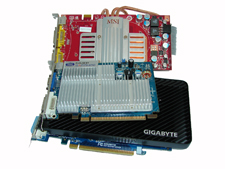 |
In keeping with our silence is golden theme, our graphics cards consist of the Gigabyte 8600GT, MSI NX8600GTS, and the Sapphire HD 2400XT. We might even have time to throw in video quality results with our recently arrived Galaxy 8600GTS HDMI card that features (if you couldn't figure it out) native HDMI output. For those of you who wondering why an AMD HD 2600 card is not included, the reason is simple: passively cooled cards were not available in time. We have now received the MSI RX2600XT and will include video comparisons with this card and potentially another HD 2600 card in our G35 preview next month.
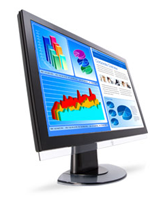 |
Of course, if you are going to show video card and IGP performance/quality comparisons then one would assume we used a monitor capable of displaying those 1080P capabilities. In fact, we used three different monitors for our test results. Our primary desktop monitors included the 24" Acer AL2416WBsd for DVI and analog output testing along with the 24" Westinghouse L2410NM for HDMI output testing. Our choice for the all-encompassing multifunction monitor in our HTPC buildup is the 42" Westinghouse TX-42F430S (which replaces the older 42" Westinghouse LVM-42w2) that will be reviewed separately in the coming weeks.
Mass Storage
 |
 |
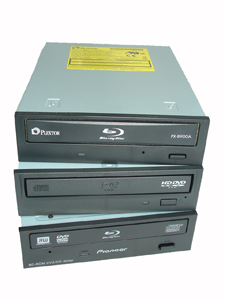 |
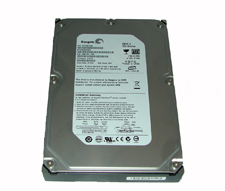 |
Audio/Visual Department
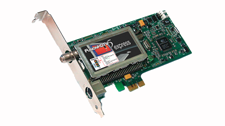 |
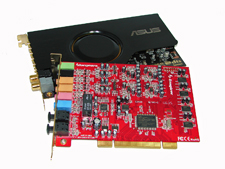 |
Speaking of Vista, Microsoft changed all the rules with the new audio stack and we will spend additional time in a side-bar article going over the changes and looking at the performance of our various audio solutions. We had a surprising number of audio solution choices for our HTPC buildup and this is one area where Creative gets thoroughly thrashed in feature comparisons and capabilities. In the end we decided to concentrate our efforts on three cards that should cover our immediate needs for both our HTPC and Home/Office systems. We selected the ASUS Xonar D2, bgears b-enspire, and the Auzentech HDA X-Plosion 7.1 DTS Connect. We are still waiting on our Auzen X-Fi Prelude 7.1 sample and will compare that card against the Creative offerings later this year. Our motherboard roundup will feature scores from our onboard audio solutions and the ASUS Xonar D2 along with a complete features comparison and test results with our various speakers and A/V receiver.
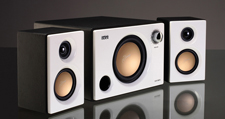 |
Like most video and audio equipment, you typically get what you pay for and speakers are no exception, but there are a few surprises. We are not going to pretend we are experts on speaker technology nor are we capable of providing the type of reviews you can get at one of the dedicated A/V sites, but we will provide our subjective review of the audio equipment that will be utilized in our roundup. To that extent, we asked our good friends at The Audio Insider what they would recommend for our testing. They came back and suggested we purchase the Swans M10 for our base multimedia system and then they highly suggested the new Swans D1080 for our musical tastes while remaining on a budget. We also decided to go for the revised Swans M200MKII to shake up our test beds while utilizing an Acculine A2 setup for our 5.1 testing. We pulled out our trusty Onkyo TX-SR605 to handle the A/V receiver duties when testing the pass-through capabilities of our onboard audio solutions.
Of Mice, Keyboards, and Enclosures
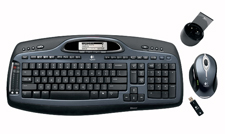 |
As an example, for our HTPC platform choice we decided a Bluetooth capable mouse/keyboard combination would offer the best compromise for the sofa users. This led us to the Microsoft Wireless Entertainment Desktop 7000 and Logitech Cordless Desktop MX 5000 Laser Combo as our two choices, neither one being anything near inexpensive. What surprised us was the number of issues we had with the Logitech choice. Most of the issues centered on the Logitech having to use the Microsoft Bluetooth stack, but in our opinion there is no way this product should have received the Vista Certified label.
For our standard wireless combinations we selected the Logitech Cordless Desktop Comfort Laser, Logitech Cordless Desktop MX 3200 Laser, and the Microsoft Wireless Optical Desktop 4000. Of course there are multitudes of different wireless keyboards and mice that can be combined together depending upon your likes or dislikes as a user. For simplicity we decided to go the package route - which sometimes works and sometimes doesn't, as we will find out in our separate reviews.
Except for HTPC work, we really prefer the wired keyboards and mice with one of our favorite combinations being the Microsoft Natural Ergonomic Keyboard 4000 or Microsoft Comfort Curve Keyboard 2000 paired with the Logitech MX-518 mouse. We like the MX-518 so much that most of our work desktops use it; it is just that good. As far as our gaming platform is concerned we will test the following keyboards: Razer Tarantula, Saitek Eclipse, and of course the Logitech G15. We will look at Creative's product lineup later on in the year. Our gaming mice consist of the Logitech G5, Razer DeathAdder, and the Razer Diamondback 3G. Unfortunately, we will have to wait a bit longer before the new Logitech G9 mouse arrives in the labs.
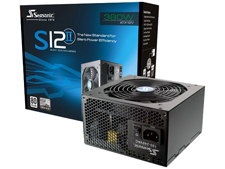 |
Considering our power requirements with the µATX platform are not going to be that great as CrossFire/SLI are out and typically the number of drives and peripherals will be limited by the small form factor, we believe something in the neighborhood of 380W to 480W should be acceptable for now and the near future. We also want a unit that is energy efficient and quiet so our logical choice is the SeaSonic S12 II 380W. We have not found a combination in our roundup testing yet that would cause us to seek a higher wattage unit. SeaSonic's own S12 II 430W would be the next logical choice but we felt like spending another $25 in this case was not worth it. There are numerous other choices that can made in this sector with Corsair, Enermax, SPI, FSP, and Antec all having good quality power supplies in this range.
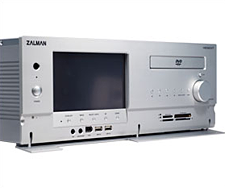 |
RAM, CPU, and OS
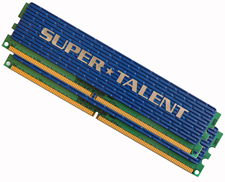 |
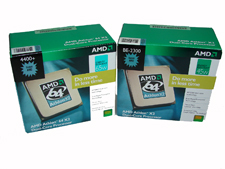 |
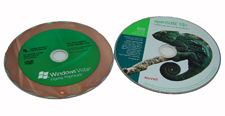 |
Our other operating system choice is SUSE Linux 10.2. We have received countless requests asking about Linux compatibility on the motherboards we review so we decided to check it out for ourselves with a commercially available package. Our testing will not be as rigorous or extensive as our standard Windows test routines. In fact, let's just say our initial foray into the world of Linux will mostly consist of checking compatibility and driver support at this time. We will provide our results at the very end of the roundup and hopefully our experiences will be helpful for those first time Linux users. (While we're really not interested in starting up a lengthy discussion of which distro is best, if you are then feel free to head over to the forums.)
Enter the Mobo
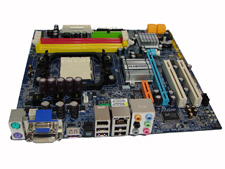 |
AMD 690G
Jetway M2A692-GHG
ASUS M2A-VM HDMI
MSI K9AGM2-FIH
Gigabyte GA-MA69GM-S2H
Biostar TA690G
Sapphire Pure Innovation PI-AM2RS690M
NVIDIA 7050
Biostar TForce TF7050-M2
ASRock AliveNF7G-HD
Abit AN-M2HD
NVIDIA 6100/6150
abit NF-M2 nView
ASUS M2NPV-VM
DFI C51PV-M2/G Infinity
ASRock AliveNF6G-VSTA
Intel ATI Radeon Express 1250
abit Fatal1ty F-I90HD
ASRock 4Core1333-FullHD
Intel G965
Intel BLKDG965OTMKR
Gigabyte GA-965GM-S2
ASUS P5B-VM
Intel G33
MSI G33M-FI
Gigabyte GA-G33M-DS2R
ASUS P5K-VM
Intel DG33TLM
There you have it, approximately 22 boards are planned to be covered utilizing seven different IGP chipsets. Our primary focus (Ed: That got lost somewhere on page 2, didn't it?) in this roundup will be on the features and reliability of each motherboard, but we will also look at performance on an individual basis. We will then perform a platform comparison that will not only compare the performance of our top µATX selections against each other in our individual categories (HTPC, Gaming, Home/Office) but also against platforms based on the more expensive and/or larger ATX cousins. Scattered in between each roundup article will be our side-bar coverage of various components utilized in our platform buildups. Over the course of the next couple of months we will also provide analysis and reviews of several components that caught our interest during the course of testing.
Oh, we almost forgot: we get to do this all over again with the P35 motherboards when we're done with the µATX segment. Where did we put the coffee maker?







